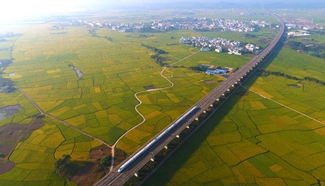JIUQUAN, Oct. 17 (Xinhua) -- China on Monday successfully launched the manned spacecraft Shenzhou-11, carrying two astronauts who will remain in space for 33 days, the longest manned mission in the country's space program to date.
Shenzhou-11, China's sixth manned spacecraft, will dock with space lab Tiangong-2, marking a step closer to its space station ambitions.
The spacecraft was launched with a Long March-2F Y11 carrier rocket at the Jiuquan Satellite Launch Center in northwest China's Gobi desert at 7:30 a.m. Monday Beijing time.
The launch was declared a success by Zhang Youxia, commander-in-chief of China's manned space program, about 19 minutes after blast-off.
President Xi Jinping, also general secretary of the Communist Party of China (CPC) Central Committee, sent a message of congratulations for the successful launch, expressing hope that "Chinese people will take bigger steps and march further in space, to make a new contribution to the building of China into a space power."
Premier Li Keqiang and Liu Yunshan, both members of Politburo Standing Committee of the CPC Central Committee, watched the live broadcast of the launch at the command center of China's manned space program in Beijing.
After docking with Tiangong-2, the astronauts will enter the space lab and stay there for 30 days.
Shenzhou-11 will then undock from Tiangong-2 and return to Earth within one day.
The two astronauts are commander Jing Haipeng, a 50-year-old veteran who participated in the Shenzhou-7 and Shenzhou-9 missions, as well as Chen Dong, 38, who is on his first space mission.
A ceremony to see the two astronauts off was held at the Jiuquan Satellite Launch Center ahead of the launch on Monday morning.
In an interview with Xinhua, Chen said he was inspired by his idol, China's first astronaut Yang Liwei, to become one of the country's elite space explorers.
Tiangong-2 was launched into space on September 15. The rendezvous will happen at an orbit about 393 kilometers above Earth, the same height the future Chinese space station will operate at.
Wu Ping, deputy director of China's manned space engineering office, said at a press conference Sunday that Tiangong-2 has already reached its preset orbit 393 kilometers above the earth, adding that it was in stable condition and would meet the requirements for docking with Shenzhou-11 and accommodating the astronauts.
The mission aims to transport personnel and materials between Earth and Tiangong-2, as well as test meeting, docking and return processes.
Other objectives include aerospace medical experiments, space science experiments and in-orbit maintenance. The astronauts will conduct three experiments designed by middle school students from the Hong Kong Special Administrative Region, including raising silkworms in space.
Jing and Chen will also be special correspondents for Xinhua, sharing their work and life in space via text, photo, audio and video, using Xinhua's global media services.
During their 30 days in the space lab, the astronauts will work eight hours per day, six days a week, according to the Astronaut Center of China.
"It is synchronized with the sleep-wake cycle on Earth and marks a transitional design to long-term flight in a space station," said Huang Weifen, deputy chief designer of the astronaut system with the center.
As the last manned space flight before China's space station mission, Huang said Shenzhou-11 offers a precious opportunity to verify the technology needed to support astronauts' life, health and work, as well as to gather data for the space station mission.
The astronauts will have access to: almost 100 kinds of food; contact with Earth through video, audio and emails; and exercise through a stationary bike and treadmill.
The mission will prove China's capability of carrying out a medium-term manned space mission.
In June 2013, three astronauts spent 15 days in space with the Shenzhou-10 mission, which docked with Tiangong-1, the predecessor of Tiangong-2.
Zhang Yulin, deputy commander-in-chief of China's manned space program, said Shenzhou-11 marks the imminent end of the exploratory stage of China's manned space program. The program will carry out manned space missions on a regular basis with the establishment of its own space station.
China's space station, which is expected to debut around 2020, may become mankind's only foothold in space when the International Space Station retires in 2024.
SPACE STATION IN SIGHT
Tiangong-2 will remain operative in orbit after the Shenzhou-11 spacecraft returns to Earth, waiting for docking with Tianzhou-1, China's first cargo spacecraft to be launched in April 2017, to verify refueling technology, a key technology for any space station.
The mission will be a key step toward China's dream of building a permanent manned space station.
In 1992, China developed a three-step strategy for a manned space program.
The first step, to send an astronaut into space and return safely, was fulfilled by Yang Liwei in the Shenzhou-5 mission in 2003.
The second step was developing advanced space flight techniques and technologies including extra-vehicular activity and orbital docking. This phase also included the launch of two space laboratories -- effectively mini space-stations that could be manned on a temporary basis.
The next step will be to assemble and operate a permanent manned space station.
Zhou Jianping, chief designer of China's manned space program, said China's space station will be comprised of a core module and two experimental modules, each weighing about 20 tonnes.
It will accommodate three to six astronauts, Zhou added.
The core module is expected to be launched around 2018, and the space station will enter into full service around 2022, with an initial designed life of at least 10 years.
With the space station, China will become the second country after the former Soviet Union to have developed a space station with its own efforts.
Currently, China's astronauts, all selected from commissioned pilots of the People's Liberation Army Air Force, are mainly responsible for operating spacecraft, according to Zhou.
"In the future, we need astronauts from different backgrounds, engineers and scientists in particular, because we will carry out scientific experiments in the space station," Zhou said.
Zhang Bonan, chief designer of the Shenzhou-11 spacecraft, said China is exploring a new generation of manned spacecraft technology, aiming to lower the cost of space flight significantly, while ensuring its safety and reliability.
"I hope a spacecraft launch will just be ordinary news one day, and more Chinese citizens can embark in space flight, just like travelling by plane," Zhang said.










